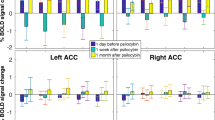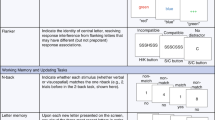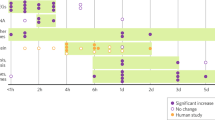Abstract
The social motivation hypothesis of autism proposes that social communication symptoms in autism-spectrum disorder (ASD) stem from atypical social attention and reward networks, where dopamine acts as a crucial mediator. However, despite evidence indicating that individuals with ASD show atypical activation in extrastriatal regions while processing reward and social stimuli, no previous studies have measured extrastriatal dopamine D2/3 receptor (D2/3R) availability in ASD. Here, we investigated extrastriatal D2/3R availability in individuals with ASD and its association with ASD social communication symptoms using positron emission tomography (PET). Moreover, we employed a whole-brain multivariate pattern analysis of resting-state functional magnetic resonance imaging (fMRI) to identify regions where functional connectivity atypically correlates with D2/3R availability depending on ASD diagnosis. Twenty-two psychotropic-free males with ASD and 24 age- and intelligence quotient-matched typically developing males underwent [11C]FLB457 PET, fMRI, and clinical symptom assessment. Participants with ASD showed lower D2/3R availability throughout the D2/3R-rich extrastriatal regions of the dopaminergic pathways. Among these, the posterior region of the thalamus, which primarily comprises the pulvinar, displayed the largest effect size for the lower D2/3R availability, which correlated with a higher score on the Social Affect domain of the Autism Diagnostic Observation Schedule-2 in participants with ASD. Moreover, lower D2/3R availability was correlated with lower functional connectivity of the thalamus-superior temporal sulcus and cerebellum–medial occipital cortex, specifically in individuals with ASD. The current findings provide novel molecular evidence for the social motivation theory of autism and offer a novel therapeutic target.
This is a preview of subscription content, access via your institution
Access options
Subscribe to this journal
Receive 12 print issues and online access
$259.00 per year
only $21.58 per issue
Buy this article
- Purchase on Springer Link
- Instant access to full article PDF
Prices may be subject to local taxes which are calculated during checkout



Similar content being viewed by others
References
American Psychiatric Association. Diagnostic and statistical manual of mental disorders. 5th ed. Text revision. Washington DC: American Psychiatric Association Publishing; 2013.
Chevallier C, Kohls G, Troiani V, Brodkin ES, Schultz RT. The social motivation theory of autism. Trends Cogn Sci. 2012;16:231–9.
Hung LW, Neuner S, Polepalli JS, Beier KT, Wright M, Walsh JJ, et al. Gating of social reward by oxytocin in the ventral tegmental area. Science. 2017;357:1406–11.
Yamaguchi Y, Atsumi T, Poirot R, Lee YA, Kato A, Goto Y. Dopamine-dependent visual attention preference to social stimuli in nonhuman primates. Psychopharmacology. 2017;234:1113–20.
Nakamura K, Sekine Y, Ouchi Y, Tsujii M, Yoshikawa E, Futatsubashi M, et al. Brain serotonin and dopamine transporter bindings in adults with high-functioning autism. Arch Gen Psychiatry. 2010;67:59–68.
Kubota M, Fujino J, Tei S, Takahata K, Matsuoka K, Tagai K, et al. Binding of dopamine D1 receptor and noradrenaline transporter in individuals with autism spectrum disorder: a PET study. Cereb Cortex. 2020;30:6458–68.
Zurcher NR, Walsh EC, Phillips RD, Cernasov PM, Tseng CJ, Dharanikota A, et al. A simultaneous [(11)C]raclopride positron emission tomography and functional magnetic resonance imaging investigation of striatal dopamine binding in autism. Transl Psychiatry. 2021;11:33.
Clements CC, Zoltowski AR, Yankowitz LD, Yerys BE, Schultz RT, Herrington JD. Evaluation of the social motivation hypothesis of autism: a systematic review and meta-analysis. JAMA Psychiatry. 2018;75:797–808.
Kleinhans NM, Richards T, Johnson LC, Weaver KE, Greenson J, Dawson G, et al. fMRI evidence of neural abnormalities in the subcortical face processing system in ASD. Neuroimage. 2011;54:697–704.
Hadjikhani N, Asberg Johnels J, Zurcher NR, Lassalle A, Guillon Q, Hippolyte L, et al. Look me in the eyes: constraining gaze in the eye-region provokes abnormally high subcortical activation in autism. Sci Rep. 2017;7:3163.
Thompson J, Thomas N, Singleton A, Piggott M, Lloyd S, Perry EK, et al. D2 dopamine receptor gene (DRD2) Taq1 A polymorphism: reduced dopamine D2 receptor binding in the human striatum associated with the A1 allele. Pharmacogenetics. 1997;7:479–84.
Hettinger JA, Liu X, Hudson ML, Lee A, Cohen IL, Michaelis RC, et al. DRD2 and PPP1R1B (DARPP-32) polymorphisms independently confer increased risk for autism spectrum disorders and additively predict affected status in male-only affected sib-pair families. Behav Brain Funct. 2012;8:19.
Boardman JD, Domingue BW, Fletcher JM. How social and genetic factors predict friendship networks. Proc Natl Acad Sci USA. 2012;109:17377–81.
Fowler JH, Settle JE, Christakis NA. Correlated genotypes in friendship networks. Proc Natl Acad Sci USA. 2011;108:1993–7.
Gangi DN, Messinger DS, Martin ER, Cuccaro ML. Dopaminergic variants in siblings at high risk for autism: Associations with initiating joint attention. Autism Res. 2016;9:1142–50.
Rodríguez-Arias M, Felip CM, Broseta I, Miñarro J. The dopamine D3 antagonist U-99194A maleate increases social behaviors of isolation-induced aggressive male mice. Psychopharmacology. 1999;144:90–4.
Cosi C, Martel JC, Auclair AL, Collo G, Cavalleri L, Heusler P, et al. Pharmacology profile of F17464, a dopamine D(3) receptor preferential antagonist. Eur J Pharmacol. 2021;890:173635.
Hull JV, Dokovna LB, Jacokes ZJ, Torgerson CM, Irimia A, Van Horn JD. Resting-state functional connectivity in autism spectrum disorders: a review. Front Psychiatry. 2016;7:205.
Kana RK, Uddin LQ, Kenet T, Chugani D, Muller RA. Brain connectivity in autism. Front Hum Neurosci. 2014;8:349.
Jia JM, Zhao J, Hu Z, Lindberg D, Li Z. Age-dependent regulation of synaptic connections by dopamine D2 receptors. Nat Neurosci. 2013;16:1627–36.
Cole DM, Beckmann CF, Oei NY, Both S, van Gerven JM, Rombouts SA. Differential and distributed effects of dopamine neuromodulations on resting-state network connectivity. Neuroimage. 2013;78:59–67.
Cole DM, Oei NY, Soeter RP, Both S, van Gerven JM, Rombouts SA, et al. Dopamine-dependent architecture of cortico-subcortical network connectivity. Cereb Cortex. 2013;23:1509–16.
Grimm O, Kopfer V, Kupper-Tetzel L, Deppert V, Kuhn M, de Greck M, et al. Amisulpride and l-DOPA modulate subcortical brain nuclei connectivity in resting-state pharmacologic magnetic resonance imaging. Hum Brain Mapp. 2020;41:1806–18.
Kahnt T, Tobler PN. Dopamine Modulates the Functional Organization of the Orbitofrontal Cortex. J Neurosci. 2017;37:1493–504.
Cole DM, Beckmann CF, Searle GE, Plisson C, Tziortzi AC, Nichols TE, et al. Orbitofrontal connectivity with resting-state networks is associated with midbrain dopamine D3 receptor availability. Cereb Cortex. 2012;22:2784–93.
Yamada M, Uddin LQ, Takahashi H, Kimura Y, Takahata K, Kousa R, et al. Superiority illusion arises from resting-state brain networks modulated by dopamine. Proc Natl Acad Sci USA. 2013;110:4363–7.
Nyberg L, Karalija N, Salami A, Andersson M, Wahlin A, Kaboovand N, et al. Dopamine D2 receptor availability is linked to hippocampal-caudate functional connectivity and episodic memory. Proc Natl Acad Sci USA. 2016;113:7918–23.
Nagano-Saito A, Lissemore JI, Gravel P, Leyton M, Carbonell F, Benkelfat C. Posterior dopamine D2/3 receptors and brain network functional connectivity. Synapse. 2017;71:e21938.
Nour MM, Dahoun T, McCutcheon RA, Adams RA, Wall MB, Howes OD. Task-induced functional brain connectivity mediates the relationship between striatal D2/3 receptors and working memory. Elife. 2019;8:e45045.
Salem AM, Ismail S, Zarouk WA, Abdul Baky O, Sayed AA, Abd El-Hamid S, et al. Genetic variants of neurotransmitter-related genes and miRNAs in Egyptian autistic patients. Sci World J. 2013;2013:670621.
Lord C, Rutter M, Le Couteur A. Autism diagnostic interview-revised: a revised version of a diagnostic interview for caregivers of individuals with possible pervasive developmental disorders. J Autism Dev Disord. 1994;24:659–85.
Lord C, Rutter M, Goode S, Heemsbergen J, Jordan H, Mawhood L, et al. Austism diagnostic observation schedule: a standardized observation of communicative and social behavior. J Autism Dev Disord. 1989;19:185–212.
Wechsler D. The psychometric tradition: developing the Wechsler Adult Intelligence Scale. Contemp Educ Psychol. 1981;6:82–85.
First MB, Williams JB, Karg RS, Spitzer RL, editors. Structured clinical interview for DSM-5—research version. Arlington, VA: American Psychiatric Association; 2015. p. 1–94.
Baron-Cohen S, Wheelwright S, Skinner R, Martin J, Clubley E. The autism-spectrum quotient (AQ): evidence from Asperger syndrome/high-functioning autism, males and females, scientists and mathematicians. J Autism Dev Disord. 2001;31:5–17.
Hollingshead AB. Two factor index of social position. New Haven: Yale University; 1957.
Watanabe M, Shimizu K, Omura T, Takahashi M, Kosugi T, Yoshikawa E, et al. A new high-resolution PET scanner dedicated to brain research. IEEE Trans Nucl Sci. 2002;49:634–9.
Terada T, Obi T, Bunai T, Matsudaira T, Yoshikawa E, Ando I, et al. In vivo mitochondrial and glycolytic impairments in patients with Alzheimer disease. Neurology. 2020;94:e1592–604.
Lammertsma AA, Hume SP. Simplified reference tissue model for PET receptor studies. Neuroimage. 1996;4:153–8.
Ito H, Takahashi H, Arakawa R, Takano H, Suhara T. Normal database of dopaminergic neurotransmission system in human brain measured by positron emission tomography. Neuroimage. 2008;39:555–65.
Ayano G. Dopamine: receptors, functions, synthesis, pathways, locations and mental disorders: review of literatures. J Ment Disord Treat. 2016;2:1000120.
Dichter GS, Damiano CA, Allen JA. Reward circuitry dysfunction in psychiatric and neurodevelopmental disorders and genetic syndromes: animal models and clinical findings. J Neurodev Disord. 2012;4:19.
Karjalainen T, Tuisku J, Santavirta S, Kantonen T, Bucci M, Tuominen L. Magia: robust automated image processing and kinetic modeling toolbox for PET neuroinformatics. Front Neuroinform. 2020;14:3.
Okubo Y, Olsson H, Ito H, Lofti M, Suhara T, Halldin C, et al. PET mapping of extrastriatal D2-like dopamine receptors in the human brain using an anatomic standardization technique and [11C]FLB 457. Neuroimage 1999;10:666–74.
Sanchez-Gonzalez MA, Garcia-Cabezas MA, Rico B, Cavada C. The primate thalamus is a key target for brain dopamine. J Neurosci. 2005;25:6076–83.
Garcia-Cabezas MA, Rico B, Sanchez-Gonzalez MA, Cavada C. Distribution of the dopamine innervation in the macaque and human thalamus. Neuroimage. 2007;34:965–84.
Suhara T, Okubo Y, Yasuno F, Sudo Y, Inoue M, Ichimiya T, et al. Decreased dopamine D2 receptor binding in the anterior cingulate cortex in schizophrenia. Arch Gen Psychiatry. 2002;59:25–30.
Yasuno F, Suhara T, Okubo Y, Sudo Y, Inoue M, Ichimiya T, et al. Low dopamine d(2) receptor binding in subregions of the thalamus in schizophrenia. Am J Psychiatry. 2004;161:1016–22.
Gilbert AR, Rosenberg DR, Harenski K, Spencer S, Sweeney JA, Keshavan MS. Thalamic volumes in patients with first-episode schizophrenia. Am J Psychiatry. 2001;158:618–24.
Fornito A, Whittle S, Wood SJ, Velakoulis D, Pantelis C, Yücel M. The influence of sulcal variability on morphometry of the human anterior cingulate and paracingulate cortex. Neuroimage. 2006;33:843–54.
McCormick LM, Ziebell S, Nopoulos P, Cassell M, Andreasen NC, Brumm M. Anterior cingulate cortex: an MRI-based parcellation method. Neuroimage. 2006;32:1167–75.
Hus V, Lord C. The autism diagnostic observation schedule, module 4: revised algorithm and standardized severity scores. J Autism Dev Disord. 2014;44:1996–2012.
Whitfield-Gabrieli S, Nieto-Castanon A. Conn: a functional connectivity toolbox for correlated and anticorrelated brain networks. Brain Connect. 2012;2:125–41.
Okauchi T, Suhara T, Maeda J, Kawabe K, Obayashi S, Suzuki K. Effect of endogenous dopamine on extrastriatal [¹¹C]FLB 457 binding measured by PET. Synapse. 2001;41:87–95.
Ward R, Calder AJ, Parker M, Arend I. Emotion recognition following human pulvinar damage. Neuropsychologia. 2007;45:1973–8.
Johnson MH. Subcortical face processing. Nat Rev Neurosci. 2005;6:766–74.
Senju A, Johnson MH. Atypical eye contact in autism: models, mechanisms and development. Neurosci Biobehav Rev. 2009;33:1204–14.
Pessoa L, Adolphs R. Emotion processing and the amygdala: from a ‘low road’ to ‘many roads’ of evaluating biological significance. Nat Rev Neurosci. 2010;11:773–83.
Nair A, Treiber JM, Shukla DK, Shih P, Muller RA. Impaired thalamocortical connectivity in autism spectrum disorder: a study of functional and anatomical connectivity. Brain. 2013;136:1942–55.
Woodward ND, Giraldo-Chica M, Rogers B, Cascio CJ. Thalamocortical dysconnectivity in autism spectrum disorder: an analysis of the autism brain imaging data exchange. Biol Psychiatry Cogn Neurosci Neuroimaging. 2017;2:76–84.
Allison T, Puce A, McCarthy G. Social perception from visual cues: role of the STS region. Trends Cogn Sci. 2000;4:267–78.
Pelphrey KA, Morris JP, McCarthy G. Neural basis of eye gaze processing deficits in autism. Brain. 2005;128:1038–48.
Tomasi D, Volkow ND. Association between functional connectivity hubs and brain networks. Cereb Cortex. 2011;21:2003–13.
Khan AJ, Nair A, Keown CL, Datko MC, Lincoln AJ, Muller RA. Cerebro-cerebellar resting-state functional connectivity in children and adolescents with autism spectrum disorder. Biol Psychiatry. 2015;78:625–34.
Lee FJ, Pei L, Moszczynska A, Vukusic B, Fletcher PJ, Liu F. Dopamine transporter cell surface localization facilitated by a direct interaction with the dopamine D2 receptor. EMBO J. 2007;26:2127–36.
Chang PK, Chien KY, Chen JC. Dopamine transporter is downregulated and its association with chaperone protein Hsc70 is enhanced by activation of dopamine D(3) receptor. Brain Res Bull. 2020;165:263–71.
Krauth A, Blanc R, Poveda A, Jeanmonod D, Morel A, Székely G. A mean three-dimensional atlas of the human thalamus: generation from multiple histological data. Neuroimage. 2010;49:2053–62.
Wing VC, Payer DE, Houle S, George TP, Boileau I. Measuring cigarette smoking-induced cortical dopamine release: A [(1)(1)C]FLB-457 PET study. Neuropsychopharmacology. 2015;40:1417–27.
Acknowledgements
We thank all the study participants and staff of Hamamatsu Medical Imaging Center, Hamamatsu Medical Photonics Foundation, the Global Strategic Challenge Center, Hamamatsu Photonics K.K., and the Department of Psychiatry, Hamamatsu University School of Medicine for their assistance with data collection. This research was supported by the Strategic Research Program for Brain Sciences of the Japan Agency for Medical Research and Development (JP16dm0107134). We thank Sarina Iwabuchi, Ph.D., and Sydney Koke, MFA, from Edanz (https://jp.edanz.com/ac) for editing a draft of this paper.
Author information
Authors and Affiliations
Contributions
HY had full access to all the data in the study and takes responsibility for the integrity of the data and the accuracy of the data analysis. Study concept and design: MY, YO, and HY. Acquisition, analysis, or interpretation of data: CM, YaK, MY, TI, TH, TG, TT, YoK, TW, HK, SB, AS, YO, and HY. Drafting of the paper: CM, TI, HY. Critical revision of the paper for important intellectual content: TI, MY, TH, TG, TT, YoK, TW, HK, SB, AS, SN, and YO. Statistical analysis: CM, TI, and HY. Obtained funding: HY. Administrative, technical, or material support: SN, YO. Study supervision: YO, HY.
Corresponding author
Ethics declarations
Competing interests
The authors declare no competing interests.
Additional information
Publisher’s note Springer Nature remains neutral with regard to jurisdictional claims in published maps and institutional affiliations.
Supplementary information
Rights and permissions
About this article
Cite this article
Murayama, C., Iwabuchi, T., Kato, Y. et al. Extrastriatal dopamine D2/3 receptor binding, functional connectivity, and autism socio-communicational deficits: a PET and fMRI study. Mol Psychiatry 27, 2106–2113 (2022). https://doi.org/10.1038/s41380-022-01464-3
Received:
Revised:
Accepted:
Published:
Issue Date:
DOI: https://doi.org/10.1038/s41380-022-01464-3
This article is cited by
-
Automatic evaluation-feedback system for automated social skills training
Scientific Reports (2023)



